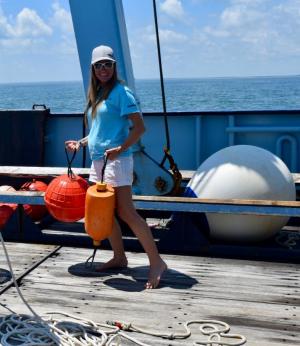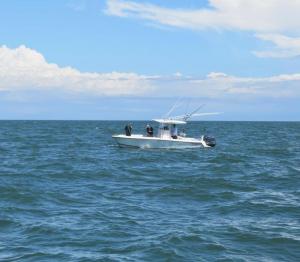White sharks elude researchers in the Delaware Bay
Lisa Mondy was near her hometown off the coast of Australia, swimming back to her wakeboard when it hit.
A great white shark had grabbed her from underneath, pinning her head and arm in its mouth. The shark shot up about three meters from the surface before pulling her down into the water.
That was six years ago, and despite the nearly fatal attack, Mondy recently flew across the world to spend two days with shark researchers and advocates hoping to study large sharks along the Mid-Atlantic Coast.
“It was the shark attack itself that made me look into sharks more,” Mondy said aboard the M/V OCEARCH in mid-July. “I always had an interest in the ocean, and then I found out what a bad place sharks are in. It's making something positive out of a not-so-positive situation.”
Mondy is working with OCEARCH and one of the nonprofit's corporate sponsors, Costa Sunglasses, to spread the word on the #DontFearTheFin campaign. She is physically scarred from her shark encounter, but wants people to understand sharks play a vital role in the world's ocean ecosystems.
“Sharks have a PR problem,” Mondy said. “When they're spotted, people say they're stalking and lurking. But fear is just a lack of understanding. OCEARCH is filling the gaps for us.”
Little is known about one of the ocean's largest predators, which has yet to be observed mating or giving birth, said Danielle Dixson, an assistant professor at the University of Delaware College of Earth, Ocean and Environment, who was also aboard the OCEARCH vessel for the organization's expedition in the Mid-Atlantic.
The crew may have come too late this time, said OCEARCH Founding Chairman and Expedition Leader Chris Fischer. A little over a month before they anchored in the bay, Twitter-famous Mary Lee, a 16-foot female white shark, and Cisco, an 8-foot-7-inch male white shark, pinged at the mouth of the Delaware Bay.
Researchers can track the movement of sharks like Mary Lee and Cisco thanks to OCEARCH's work. The GPS tracker on the dorsal fins of tagged sharks sends a signal each time the tracker reaches the surface.
“We not only try and understand where they are, which is what everybody kind of connects to on the tracking, but the rest of the science is to try to figure out what they are doing where they are,” he said. “We're really kind of just chasing data, and doing data creation for the future management of the resource.”
Researchers know great white sharks frequent the Delaware Bay. They just don't know why.
That's why the crew at OCEARCH invited scientists from more than a dozen research institutions across the Mid-Atlantic to come aboard during the nonprofit's 29th shark tagging expedition.
“We know very little about them, so getting baseline data is vital,” Dixson said. “The seas are under threat from everything: pollution, climate change, temperature rise, and the currents are shifting in weird ways. If we don't have baseline data, then we don't have any idea if something is threatened or being affected by those changes.”
Dixson said people take for granted that a doctor can easily take a blood sample and tell them if their cholesterol is too high. But for large shark species, like white sharks, that information is not available because scientists don't know what normal looks like.
Studying large marine animals like white sharks is easier said than done. The M/V OCEARCH, once a king crab fishing boat featured on “The Deadliest Catch,” is specially fitted with a mechanical platform, making it easier for veterinarians to gather samples, including blood, tissue and ultrasounds.
On most other research vessels, samples are collected over the side of the boat, with researchers dangling above the water and the hooked shark.
Sometimes that's OCEARCH's style, too. After three weeks of searching for elusive white sharks along the Mid-Atlantic coast, the team hooked two sand tiger sharks as the expedition neared its end.
Dixson was on board for the excitement. The sharks, one male and one female both under 8-feet-long, had snagged some bait from drum lines set in the water.
Experts in a smaller 35-foot boat called the Contender used a gaff hook to grab the line and guide the shark to the side of the boat. When larger sharks are hooked, they're walked to the platform on the M/V OCEARCH, where scientists and veterinarians act like a NASCAR pit crew as they take samples and measurements before releasing the shark.
Dixson said she watched from the M/V OCEARCH as veterinary specialist Harley Newton of the New York Aquarium and Wildlife Conservation Society dangled off the side of a smaller vessel to grab all the samples she needed.
“It was pretty cool to see how fast they get it,” Dixson said, estimating Newton worked on the shark for about 10 minutes, and it took about 30 minutes to process the samples and data.
Tagging the sand sharks was the most action the crew had seen since the first day of the expedition, when an estimated 9-foot white shark swam by the boat off the coast of Virginia, completely ignoring the bait strung below the surface.
Like any good fisherman, scientists know a big part of the job is simply having patience. Between that sighting and the sand tigers caught on the second-to-last day of the expedition, scientists, marketers, shark survivors and crew members waited quietly for word of a catch.
When the crew catches a shark, they take blood samples, a muscle biopsy, a fin clip, bacteria sample, conduct an ultrasound, tag the shark's dorsal fin and insert an acoustic tag, explained Mike Hyatt, chief scientist on OCEARCH's Expedition Mid-Atlantic and a veterinarian at Adventure Aquarium in Camden, N.J.
“We have an unprecedented opportunity to work with these large animals,” Hyatt said. “Now we need to start filling the gaps in the data.”
On this expedition, researchers from 18 organizations hoped to collect data for 12 different studies that examined shark DNA, how the animals use the ocean and the physiological effects of stress, among other topics.
Hyatt said overfishing and other threats have reduced worldwide shark populations by about 90 percent. He said while it's unclear how white sharks are currently using the Delaware Bay, it's possible that the Mid-Atlantic region could be a great place for white sharks to find food, or it may be a secondary pupping ground.
“If we can know where they're migrating, maybe those are places to protect,” he said. “In order to make policy changes, we need the science to leverage those changes.”











.jpg)


















































